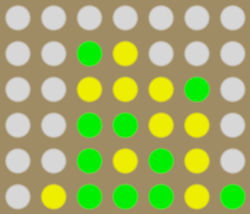Connect Four
|
|
Connect Four (also known as Plot Four) is a two-player board game in which the objective is to be the first to get four of one's own discs in a line.
The game was published by Milton Bradley in 1974; a non-proprietary version is known as "The Captain's Mistress".
| Contents |
Rules
The game is played on a board with 7 columns and 6 rows, which is placed in a vertical position. The players have 21 discs each, distinguished by color. The players take turns in dropping discs in one of the non-full columns. The disc then occupies the lowest unoccupied square on that column. A player wins by placing four of their own discs consecutively in a line (row, column or diagonal), which ends the game. The game ends in a draw if the board is filled completely without any player winning.
Strategy and tactics
Beginners will often overlook a simple threat to connect four discs; it is therefore important to always check all vertical, horizontal and diagonal lines before making a move.
In more advanced play, one aims at forcing a win by making two threats simultaneously; conversely, one should prevent the opponent from doing so. For instance, in the figure on the right, it is green's turn. Yellow will win on their next turn irrespective of green's move because of the threat of extending the diagonal of three consecutive yellow discs to four by dropping a disc either on the third or on the last column, only one of which can be blocked by green.
As a general rule of thumb, discs played in the center columns are more valuable than border column discs, because they participate in more potential four-disc lines (and accordingly limit the opponent's opportunities).
Among good players, the short term goal is to connect three discs, thereby preventing the opponent from playing in a certain column. Towards the end, the game then often turns into a complex counting match: both players try to win by forcing the other to play a certain column. In these situations, it is useful to realize that, if it's your move, then after filling an even number of places, it's still your move. Every column has an even number of places.
Beyond this, it turns out that the strategies for the first and second player differ markedly. Every three aligned discs of one color create a hole, a place which when filled with the right color would yield four-in-a-row. A hole is called even or odd depending on whether it occurs in an even- or odd-numbered row (with the bottom row being numbered 1). In order for the first player to win, he needs more odd holes than his opponent; the even holes don't matter. In order for the second player to win, she needs at least two more odd holes than her opponent, or the same number of odd holes and at least one even hole. (These rules are somewhat simplified: it gets more complicated if several holes occur in the same column; most of the time, holes occurring above other holes are useless.)
Perfect play
Connect Four has been solved independently by Victor Allis and James D. Allen. With perfect play, the first player can force a win by starting in the middle column. Starting in the two adjacent columns allows the second player to reach a draw; starting with the border columns even allows the second player to force a win.
Trivia
- Connect Four is popular in the beer bars of Thailand and Argentina.
- The Milton Bradley version was immortalized by a late 1970s commercial that ended with the tag line, "Pretty sneaky, sis!"
See Also
External links
- Connect Four (http://www.farfarfar.com/games/connect_four/) - Connect Four resources including a downloadable strong Connect Four Java applet with source code, JavaScript Connect Four programs, strategy, references, and related links.
- John's Connect Four Playground (http://www.cwi.nl/~tromp/c4/c4.html) - A perfect playing applet, a solver benchmark with source, optimal board representation, and perfect play results for various board sizes.
- Expert Play in Connect-Four (http://www.cwi.nl/~tromp/c4.html) - by James D. Allen
- Victor Allis's Master's Thesis containing the solution of the game (http://www.cs.vu.nl/~victor/thesis.html)
- (this link is sometimes 'forbidden.' Alternatives: archive (http://web.archive.org/web/20040205050946/http://www.cs.vu.nl/~victor/thesis.html) and ftp://ftp.cs.vu.nl/pub/victor/ )
- Mustrum (http://www.lbremer.de/mustrum_e.html) - A very strong freeware program for MS-Windows.
- Keith Pomakis' Connect Four Page (http://www.pomakis.com/c4/) - Includes an online one-player Connect Four game.
- Multiplayer Connect 4 (http://www.flyordie.com/board-games/fourinarow.html) -
- Connect Four (http://www.ragnarius.com/en/myshare/help_connect4.php) - Windowsprogram, You play against the computer!de:Vier gewinnt

